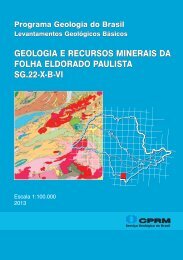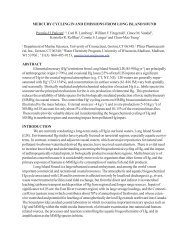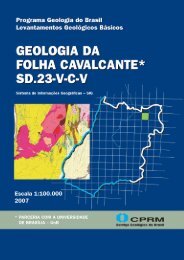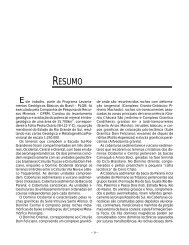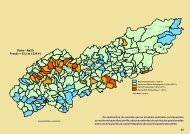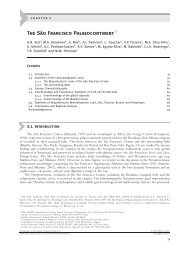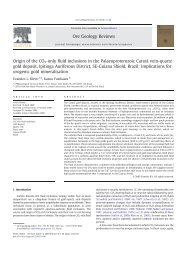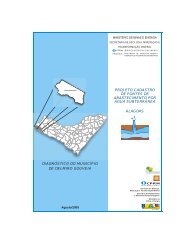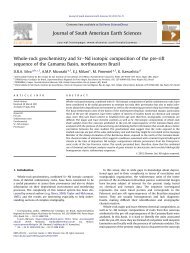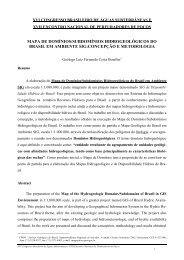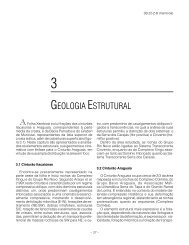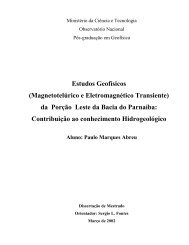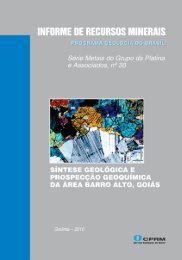Fabrics of pre- and syntectonic granite plutons and ... - CPRM
Fabrics of pre- and syntectonic granite plutons and ... - CPRM
Fabrics of pre- and syntectonic granite plutons and ... - CPRM
Create successful ePaper yourself
Turn your PDF publications into a flip-book with our unique Google optimized e-Paper software.
Granite foliation poles<br />
Campina Gr<strong>and</strong>e Serra Redonda<br />
48 21<br />
N<br />
southern domain<br />
S: 88<br />
L: 60<br />
Campina<br />
Gr<strong>and</strong>e<br />
Fig. 6. Drag-fold in b<strong>and</strong>ed gneiss hosting a diorite dike. The b<strong>and</strong>ed gneiss<br />
forms the hanging wall rocks thrusted on porphyritic <strong>granite</strong> <strong>and</strong> diorite <strong>of</strong><br />
the Serra Redonda pluton. The feature suggest the dike crosscut the gneissic<br />
b<strong>and</strong>ing in the latest ductile stage <strong>of</strong> the thrust movement.<br />
8 km<br />
Serra Redonda pluton Host regional rocks<br />
eastern domain<br />
porphyritic <strong>granite</strong> orthogneiss (Early Neoproterozoic)<br />
diorite<br />
C.J. Archanjo et al. / Journal <strong>of</strong> Structural Geology 30 (2008) 310e326<br />
MSZ<br />
Specimen for zircon U/Pb Shrimp analysis<br />
Matinhas shear zone<br />
(MSZ)<br />
S: 137<br />
L: 104<br />
GSZ<br />
NE domain<br />
Paleoproterozoic basement<br />
S: 129<br />
L: 74<br />
Galante shear zone<br />
(GSZ)<br />
Fig. 5. Structural map <strong>of</strong> the Campina Gr<strong>and</strong>e Magmatic Complex <strong>and</strong> country rocks. In the orientation stereograms the foliation pole (S, shaded area) <strong>and</strong><br />
lineation (L) are shown on Schmidt net (lower hemisphere). Inset: the planar magmatic fabric <strong>of</strong> Campina Gr<strong>and</strong>e <strong>and</strong> Serra Redonda <strong>plutons</strong>. MSZ <strong>and</strong> GSZ<br />
correspond to, respectively, the Matinhas <strong>and</strong> Galante shear zones.<br />
S: 177<br />
L: 141<br />
S: 60<br />
L: 44<br />
some <strong>of</strong> them show a crosscutting relationship with a second,<br />
later, magmatic domain. Cores occur in most <strong>of</strong> the grains.<br />
These are rounded in shape; generally, complex internal structures<br />
are absent. Radial micr<strong>of</strong>ractures from the cores are also<br />
<strong>pre</strong>sent, probably induced by metamictization-related volume<br />
expansion <strong>of</strong> the crystal lattice (e.g. Lee <strong>and</strong> Tromp, 1995).<br />
Fifteen analyses were performed on different zircon grains<br />
(Table 1) <strong>and</strong> plotted on a conventional Wetherill U/Pb Concordia<br />
diagram (Fig. 7). Eight analyses are significantly discordant,<br />
<strong>and</strong> were excluded from the age calculation. Two analyses<br />
(spots #11, #15) with high 207 *Pb/ 206 *Pb ages, are attributed<br />
to inherited, old zircons. The five remaining analyses (spots<br />
#1, #3, #4, #5, #6) define a Concordia age <strong>of</strong> 591 5.3 Ma,<br />
the best estimate for crystallization <strong>of</strong> the Teixeira pluton.<br />
Zircons extracted from the Serra Redonda pluton (sample<br />
SR1) are prismatic <strong>and</strong> euhedral, between 200 to 300 mm in<br />
length. The color varies from pinkish to light brown. CL images<br />
reveal typical magmatic oscillatory zoning. Eighteen zircon<br />
grains were dated (see Table 1). Most <strong>of</strong> the analytical points<br />
315



